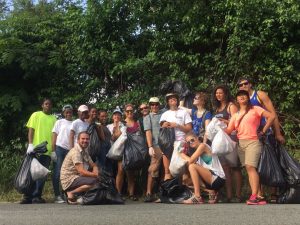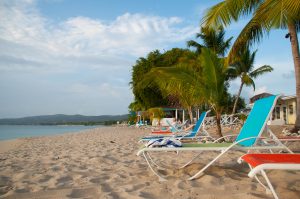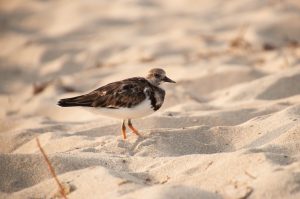A crushed Orange Fanta can. A cigarette butt still burning on one end. A torn plastic bag tangled among roots. One by one, we wrestle the brightly coloured traces of human footprints from the surrounding vegetation. A shattered Heineken bottle. A crumpled McDonalds wrapper. A rusted tire rim. Trash.
It is day two in St. Croix and we roll out of bed at noon, groggy from the abrupt switch night-time beach monitoring. Along with the interns from “turtle camp” who were already accustomed to the nocturnal lifestyle, we trooped off for an afternoon of trash picking.
Coordinated by the St. Croix Environmental Association (SEA) in conjunction with Earth Day, we took part in the 7th annual Project CLEAN (Crucian Litter Elimination Action Now). As a lead up to a 56-mile triathlon that will run through St. Croix, we helped clear the path along with some local high-schoolers. It was sweltering hot and cars whizzed by next to us (occasionally they’ll give us a friendly hoot and a thumbs up), but it was also deeply satisfying with each piece of rubbish we cleared, knowing that it will be properly disposed of this time. We picked up some Cruician slang from the students and learnt a bit about island life and their aspirations.
Trash warriors. Total haul: 13 bags of rubbish cleared in 2 hours, all cans recycled. Photo by Matthew Godfrey.
Jennifer Valiulis, environmental education coordinator of SEA, admits that litter will likely line the newly-clean roads again the next day. She has launched campaigns to raise awareness of the risks of improper waste disposal beyond being simply aesthetically displeasing: leachates can contaminate the soil and air, litter can be carried into the marine environment, terrestrial and marine wildlife will suffer. However, it takes extensive education, starting from a young age, to instill a sense of environmental stewardship among the people.
A vigorous afternoon of walking could not diminish our energy. Erin, Samantha, and I decided to stay out for a whole night of beach monitoring with the interns from turtle camp. From 7:30 pm to 4:30 am, we walked that mile-long beach at Sandy Point.
Activity-filled days and nights leave us little time to just sit back and enjoy the beautiful beach!
Sure enough, the gamble of sleep deprivation paid off with no less than four great leatherbacks coming up to nest. It was an honour to be up close and personal with these prehistoric beasts, measuring their lengths, triangulating their nests, and recording any injuries. Two were expected returnees who had already nested once this season, the rest were tagged from another beach.
The highlight of the night was definitely having to relocate one of the turtle nests. It was laid in the ‘erosion zone’ where it risks being washed out by the waves. We watched as one of the interns got belly down in the sand, slip a bag into the turtle’s egg chamber just before she started laying, and caught the eggs coated with cloaca jelly. Elizabeth Anne got to be a surrogate turtle mum as she carried the bag of potentially more than 80 developing babies while the interns made a body pit and performed their best nesting-turtle imitation, building the perfectly shaped nest down to its dimensions of width and depth.
We each got to put a leatherback turtle egg into the nest. Holding the fist-sized lump, soft and white, I couldn’t help but admire nature’s work, appreciating the mother’s toll as it scoots awkwardly out of its element to dig a nest. Yet, the hatchlings will wander out to the sea in about 60 days and have to evade predators in a fight where most will not survive.
However, knowing that even before they can emerge, the leatherback hatchlings and their other sea turtle brethren around the world face to risk of irresponsible beach usage and poaching by humans, I gain even more appreciation for the massive amount of effort people like Dr. Kelly Stewart and her sea turtle team puts in to help these endangered animals. Above all, I’m just glad to be a tiny part of it.
As leatherback turtles are endangered and we are in a protected area, no night photography is allowed to ensure that the flash does not disrupt nesting behaviour. In lieu of that, here is a picture of another beach user, the ruddy turnstone.



